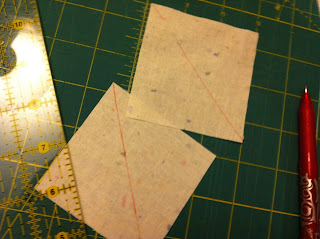 |
| This shows pretty clearly the edge and corner blocks, which are different from the main block design. The edge blocks are basically half a regular block, and the corner blocks only have a quarter of the regular block. |
 |
| One thing that doesn't show up too clearly in the layout is the individual patterns of the various fabrics, but that's okay at this step. What you are seeing is a high-level view of colors and movement, and not a close-up view of the intricate patterns found in the batik fabrics. |
 |
| There is a nice secondary pattern or two developing in the layout - white diamonds, and colored blocks surrounding them. Secondary patterns are always fun to find, and make a quilt design more interesting - the eye continues to follow the different patterns and look around and around the quilt. |
Now that the blocks are all completed, the next step is to lay them out to make the quilt design. I used a plastic, flannel-backed tablecloth as my design wall. My goal is to have different fabrics where the blocks meet, and to have a randomized pattern between the blocks.
The actual quilt will look a bit different, as the blocks will be surrounded by sashing and posts, but more on that later.
The design wall worked great, except that it was too short. Also, note to self: if using this particular setup again, be sure to capture the layout immediately. I left it hanging, went to the store, and came back, and most of the blocks had slipped off the design wall and fallen to the floor.



































